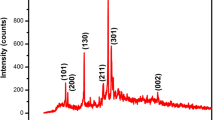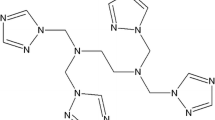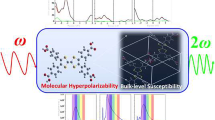Abstract
The electrical conductivity and optical properties of bis-diethylaminokumarin have been investigated. The electrical conductivity of the compound exhibited three-dimensional hopping conduction in the temperature range 295–321 K. The compound shows a typical semiconductor property, and its semiconducting property results from delocalization of the π-electrons in the structure. To determine the optical band gap of the compound, an optical absorption study was made in the wavelength range 250–600 nm. The optical study revealed that the optical transition is the allowed indirect one. The electronic parameters, such as the electrical conductivity at room temperature σ25, activation energy E, and optical band gap E g of the compound are 1.46×10−5 S/cm, 0.42 eV, and 2.46 eV, respectively. These values are in agreement with electronic parameters of organic semiconductors.
Similar content being viewed by others
References
R. V. Rao, M. H. Shridhar, S. Ganesh, and K. C. Prashanth, Chem. Phys. Lett. 341, 306 (2001).
G. D. Sharma, D. Saxena, and M. S. Roy, Synth. Met. 123, 189 (2001).
Extended Linear Chain Compounds, Ed. by J. S. Miller (Plenum, New York, 1983), Vols. 1–3.
J. P. Farges, Organic Conductors (Marcel Dekker, New York, 1994).
D. P. Specht, P. A. Martic, and S. Farid, Tetrahedron 38, 1203 (1982).
F. Yakuphanoglu, PhD Thesis (Firat Univ.,Elazig, Turkey, 2002).
B. I. Shklovskii and A. L. Éfros, Electronic Properties of Doped Semiconductors (Nauka, Moscow, 1979; Springer, Berlin, 1984).
H. Hasegawa, S. Yazaki, and T. Shimizu, Solid State Commun. 26, 4070 (1978).
F. Urbach, Phys. Rev. 92, 627 (1966).
E. Abd El-Wahabb, M. M. El-Samandouy, and M. Fadel, Appl. Surf. Sci. 174, 106 (2001).
Author information
Authors and Affiliations
Additional information
From Fizika i Tekhnika Poluprovodnikov, Vol. 38, No. 4, 2004, pp. 486–489.
Original English Text Copyright © 2004 by Yakuphanoglu, Aydin, Arsu, Sekerci.
Rights and permissions
About this article
Cite this article
Yakuphanoglu, F., Aydin, M., Arsu, N. et al. A small-molecule organic semiconductor. Semiconductors 38, 468–471 (2004). https://doi.org/10.1134/1.1734676
Received:
Accepted:
Issue Date:
DOI: https://doi.org/10.1134/1.1734676




